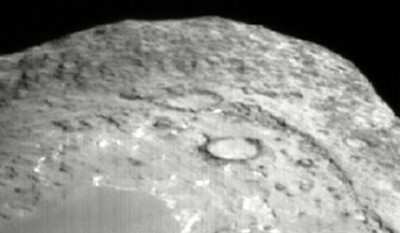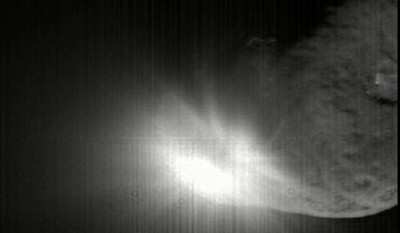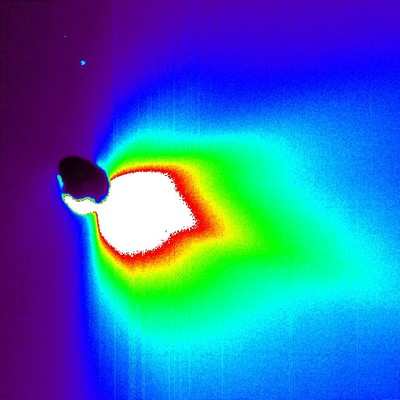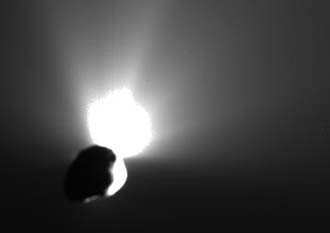"Paint By Numbers"
Painting by the numbers is a good description of how scientists
create pictures of everything from atoms in our bodies to asteroids
and comets in our solar system. Researchers involved in NASA's Deep
Impact mission have been doing this kind of work since the
mission's July 4th collision with comet Tempel 1.

"Prior to our Deep Impact experiment, scientists had a lot of
questions and untested ideas about the structure and composition of
the nucleus, or solid body of a comet, but we had almost no real
knowledge," said Deep Impact principal investigator Michael
A'Hearn, a professor of astronomy at the University of Maryland,
College Park, MD. "Our analysis of data produced by Deep Impact is
revealing a great deal, much of it rather surprising."
For example, comet Tempel 1 has a very fluffy structure that is
weaker than a bank of powder snow. The fine dust of the comet is
held together by gravity. However, that gravity is so weak, if you
could stand on the bank and jump, you would launch yourself into
space.
Another surprise for A'Hearn and his colleagues was the evidence
of what appears to be impact craters on the surface of the comet.
Previously two other comets had their nuclei closely observed, and
neither showed evidence of impact craters.

"The nucleus of Tempel 1 has distinct layers shown in
topographic relief ranging from very smooth areas to areas with
features that satisfy all the criteria for impact craters,
including varying size," A'Hearn said. "The problem in stating with
certainty that these are impact craters is that we don't know of a
mechanism by which some comets would collide with the flotsam and
jetsam in our solar system, while others would not," he added.
According to A'Hearn, one of the more interesting findings may
be the huge increase in carbon-containing molecules detected in
spectral analysis of the ejection plume. This finding indicates
comets contain a substantial amount of organic material, so they
could have brought such material to Earth early in the planet's
history when strikes by asteroids and meteors were common.
Another finding is the comet interior is well shielded from the
solar heating experienced by the surface of the comet nucleus.
Mission data indicates the nucleus of Tempel 1 is extremely porous.
Its porosity allows the surface of the nucleus to heat up and cool
down almost instantly in response to sunlight. This suggests heat
is not easily conducted to the interior and the ice and other
material deep inside the nucleus may be pristine and unchanged from
the early days of the solar system, just as many scientists had
suggested.

"The infrared spectrometer gave us the first temperature map of
a comet, allowing us to measure the surface's thermal inertia, or
ability to conduct heat to the interior," said Olivier Groussin,
the University of Maryland research scientist who generated the
map.
It is this diligent and time consuming analysis of spectral data
that is providing much of the "color" with which Deep Impact
scientists are painting the first ever detailed picture of a comet.
For example, researchers recently saw emission bands for water
vaporized by the heat of the impact, followed a few seconds later
by absorption bands from ice particles ejected from below the
surface and not melted or vaporized.
"In a couple of seconds the fast, hot moving plume containing
water vapor left the view of the spectrometer, and we are suddenly
seeing the excavation of sub-surface ice and dust," said Deep
Impact co-investigator Jessica Sunshine, with Science Applications
International Corporation, Chantilly, VA. "It is the most dramatic
spectral change I've ever seen."

These findings were published in the September 9 issue of the
journal Science, and presented at the Division for Planetary
Sciences meeting in Cambridge, England. Mission scientists are
filling in important new portions of a cometary picture that is
still far from finished.
 ANN's Daily Aero-Linx (04.16.24)
ANN's Daily Aero-Linx (04.16.24) Aero-News: Quote of the Day (04.16.24)
Aero-News: Quote of the Day (04.16.24) Airborne 04.10.24: SnF24!, A50 Heritage Reveal, HeliCycle!, Montaer MC-01
Airborne 04.10.24: SnF24!, A50 Heritage Reveal, HeliCycle!, Montaer MC-01 Airborne 04.12.24: SnF24!, G100UL Is Here, Holy Micro, Plane Tags
Airborne 04.12.24: SnF24!, G100UL Is Here, Holy Micro, Plane Tags Airborne-Flight Training 04.17.24: Feds Need Controllers, Spirit Delay, Redbird
Airborne-Flight Training 04.17.24: Feds Need Controllers, Spirit Delay, Redbird






